EnGenius Technologies EWS300AP Wireless N300 Managed Indoor Access Point User Manual EWS Series
EnGenius Technologies Wireless N300 Managed Indoor Access Point EWS Series
Users manual.pdf
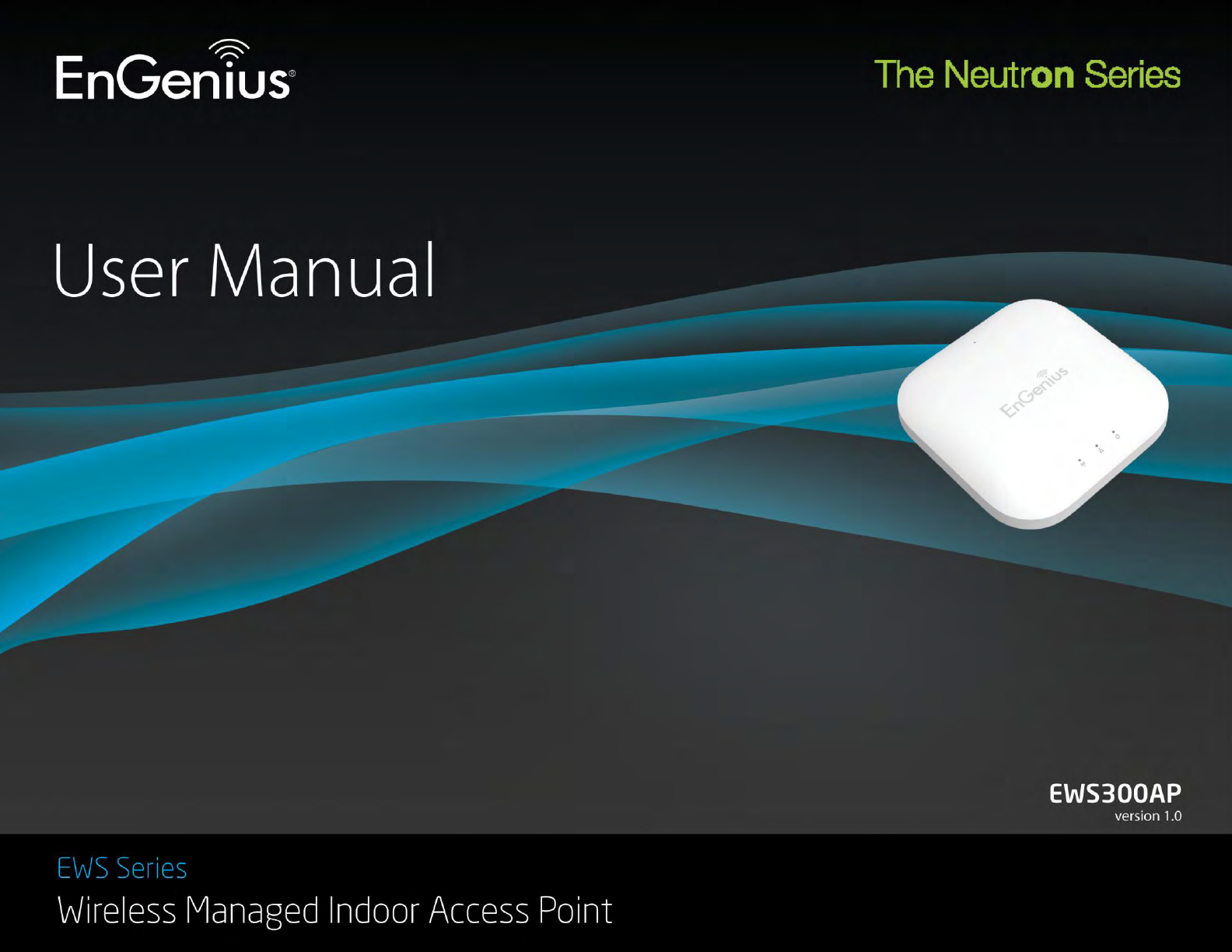
Table of Contents
Chapter 1 ........................................................................................................................................................................................ 5
Key Features ............................................................................................................................................................................................ 6
Introduction .............................................................................................................................................................................................. 7
System Requirements ............................................................................................................................................................................... 8
Package Contents ..................................................................................................................................................................................... 8
Applications ............................................................................................................................................................................................. 9
Technical Specifications ........................................................................................................................................................................ 10
Physical Interface ................................................................................................................................................................................... 12
Chapter 2 ...................................................................................................................................................................................... 13
Considerations for Wireless Installation ................................................................................................................................................ 14
Computer Settings .................................................................................................................................................................................. 15
Hardware Installation ............................................................................................................................................................................. 19
Mounting the Access Point .................................................................................................................................................................... 20
Chapter 3 ...................................................................................................................................................................................... 23
Default Settings ...................................................................................................................................................................................... 24
Web Configuration ................................................................................................................................................................................. 25
Chapter 4 ...................................................................................................................................................................................... 27
Device Status .......................................................................................................................................................................................... 28
Connections ............................................................................................................................................................................................ 31
Chapter 5 ...................................................................................................................................................................................... 32
IPv4 Settings .......................................................................................................................................................................................... 33
IPv6 Settings .......................................................................................................................................................................................... 34
Spanning Tree Settings........................................................................................................................................................................... 35
Chapter 6 ...................................................................................................................................................................................... 36
2.4GHz SSID Profile.............................................................................................................................................................................. 37
Wireless Security ................................................................................................................................................................................... 38
Wireless MAC Filter .............................................................................................................................................................................. 41
Traffic Shaping ....................................................................................................................................................................................... 42
Guest Network ....................................................................................................................................................................................... 43
Fast Handover ........................................................................................................................................................................................ 45
Management VLAN Settings ................................................................................................................................................................. 46
Chapter 7 ...................................................................................................................................................................................... 47
SNMP Settings ....................................................................................................................................................................................... 48
CLI/SSH Settings ................................................................................................................................................................................... 50
HTTPS Settings...................................................................................................................................................................................... 51
Email Alert ............................................................................................................................................................................................. 52
Date and Time Settings .......................................................................................................................................................................... 53
WiFi Scheduler ....................................................................................................................................................................................... 54
Tools ....................................................................................................................................................................................................... 56
LED Control ........................................................................................................................................................................................... 59
Device Discovery ................................................................................................................................................................................... 60
Chapter 8 ...................................................................................................................................................................................... 61
Account Setting ...................................................................................................................................................................................... 62
Firmware Upgrade ................................................................................................................................................................................. 63
Backup/Restore ...................................................................................................................................................................................... 64
System Log ............................................................................................................................................................................................ 65
Reset ....................................................................................................................................................................................................... 66
Logout .................................................................................................................................................................................................... 67
Appendix ...................................................................................................................................................................................... 68
Appendix A - FCC Interference Statement ............................................................................................................................................ 69
Appendix B - IC Interference Statement ................................................................................................................................................ 71
Chapter 1
Product Overview
Introduction
Key Features
Deploy and manage with ease using EWS Series Wireless Management Switches.
Internal Omni-Directional antennas optimized for maximum RF performance.
Backward compatible with IEEE802.11a/b/g/n wireless devices.
Integrated Power over Ethernet (IEEE802.3af) for lowering deploying costs. Can be powered using either the included power
adapter or via PoE with PoE 802.3af capable Switches or Injectors.
SNMP v1/ v2c/v3, MIB I/II supported.
WEP/WPA/WPA2 wireless encryption.
IPv4/IPv6 support.
Effective and flexible bandwidth management.
Client limiting and fast handover supported.
Secure Guest Network option available.
Ideal for audio, video and voice application.
Stylish low profile design with ceiling mounting kit.

Introduction
This device is an enhanced-powered, long-range wireless access point. It is designed to operate in numerous environments; from large
homes, small and medium-sized businesses, multiple-floor offices, hotels, and other venues, to larger enterprise deployments. Its
enhanced-powered, long-range characteristics make it a cost-effective alternative to ordinary Access Points that don’t have the range
and reach to connect to a growing number of wireless users who wish to connect to a large hotspot or business network.
To protect sensitive data during wireless transmissions, the device offers different encryption settings for wireless transmissions,
including industry standard WPA and WPA2 encryption. The device also includes MAC address filtering to allow network
administrators to offer network access only to known computers and other devices based on their MAC addresses.
System Requirements
The following are the Minimum System Requirements in order to configure the device:
Computer with an Ethernet interface or wireless network capability
Windows OS (XP, Vista, 7, 8), Mac OS, or Linux-based operating systems
Web-Browsing Application (i.e. : Internet Explorer, Firefox, Chrome, Safari, or another similar browser application)
Package Contents
The package contains the following items (all items must be in package to issue a refund):
EWS Indoor Access Point
Power Adapter
Mounting Bracket
T-Rail Mounting Kit
Mounting Screw Set
Quick Installation Guide
Applications
Wireless LAN (WLAN) products are easy to install and highly efficient. The following list describes some of the many applications
made possible through the power and flexibility of WLANs:
Difficult-to-Wire Environments: There are many situations where wires cannot be installed, deployed easily, or cannot be
hidden from view. Older buildings, sites with multiple buildings, and/or areas that make the installation of a Ethernet-based
LAN impossible, impractical or expensive are sites where WLAN can be a network solution.
Temporary Workgroups: Create temporary workgroups/networks in more open areas within a building; auditoriums,
amphitheaters classrooms, ballrooms, arenas, exhibition centers, or temporary offices where one wants either a permanent or
temporary Wireless LAN established.
The Ability to Access Real-Time Information: Doctors/Nurses, Point-of-Sale Employees, and/or Warehouse Workers can access
real-time information while dealing with patients, serving customers, and/or processing information.
Frequently Changing Environments: Set up networks in environments that change frequently (i.e.: Show Rooms, Exhibits, etc.).
Small Office and Home Office (SOHO) Networks: SOHO users require a cost-effective, easy, and quick installation of a small
network.
Training/Educational Facilities: Training sites at corporations or students at universities use wireless connectivity to exchange
information between peers and easily access information for learning purposes.
Technical Specifications
Radio Specification
Operation Frequency:
- 2.4GHz: 802.11b/g/n with max data rate up to 300Mbps
Radio Chains / Spatial Streams:
- 2 x 2 / 2
Supported Radio Technology:
- 802.11b: direct-sequence spread-spectrum (DSSS)
- 802.11g/n: orthogonal frequency-division multiplexing (OFDM)
Channelization:
- 802.11n with 20/40 MHz channel width
- 802.11b/g with 20 MHz channel width
Supported Modulation:
- 802.11b: BPSK, QPSK, CCK
- 802.11g/n: BPSK, QPSK, 16-QAM, 64-QAM
Supported data rates (Mbps):
- 802.11b: 1, 2, 5.5, 11
- 802.11g: 6, 9, 12, 18, 24, 36, 48, 54
- 802.11n: 6.5 to 300 (MCS0 to MCS15)
Physical & Environment
Power Source:
- DC Input: 12 VDC/1A
- PoE: compatible with 802.3af
Internal High Gain Antenna:
- 2 x 5dBi 2.4GHz antennas
Interface:
- 1 x 10/100/1000Mbps Ethernet Port with 802.3af PoE
- 1 x DC power connector
- 1 x Reset button
Dimensions (W x D x H):
- 129 x 129 x 43.5mm
Mounting:
- Ceiling mount or wall mount
Environment:
- Operating temperature: 0°C~50°C
- Operating humidity: 0%~90% typical
- Storage temperature: -20°C~60°C
Wireless
Operating Mode:
- AP Mode
Auto Channel Selection:
- Setting varies by regulatory domains
SSIDs:
- Supports up to 8 SSIDs
VLAN Tag / VLAN Pass-through
Wireless Client List
Guest Network:
- Allocates a separate network segment for guest access within
the same WLAN
QoS:
- Supports 802.11e/WMM
Mobility:
- PMKSA support for fast roaming
Security:
- WEP encryption: 64/128/152-bit
- WPA/WPA2 Enterprise/PSK
- Hidden SSID
- MAC address filtering (up to 50 MAC)
- Client isolation
Management
Deployment Options
- Standalone Mode
- Managed Mode (by Neutron Switch)
Configuration
- Web interface (HTTP)
- SNMP v1/v2c/v3 with MIB I/II and private MIB
- CLI (Telnet)
Firmware Upgrade
- Web interface or CLI (FTP/HTTP)
Backup / Restore Settings
- Revert to factory default settings
Schedule Reboot:
- Specifies interval to reboot system periodically
E-mail Alert / Syslog Notification

Physical Interface
1. Reset Button: Press and hold for over 10 seconds to reset to factory default settings.
2. LED Indicators: LED lights for WLAN 2.4GHz, LAN, and Power
3. LAN Port (802.3af PoE): Ethernet port for RJ-45 cable.
4. Power Connector: 12V DC IN for Power Adapter.
Chapter 2
Before You Begin
Before You Begin
This section will guide you through the installation process. Placement of the EnGenius Access Point is essential to maximize the
Access Point’s performance. Avoid placing the Access Point in an enclosed space such as a closet, cabinet, or stairwell.
Considerations for Wireless Installation
The operating distance of all wireless devices can often not be pre-determined due to a number of unknown obstacles in
the environment in which the device is deployed. Obstacles such as the number, thickness, and location of walls, ceilings,
or other objects that the Access Point’s wireless signals must pass through can weaken the signal. Here are some key
guidelines for allowing the Access Point to have an optimal wireless range during setup.
Keep the number of walls and/or ceilings between the Access Point and other network devices to a minimum. Each wall and/or
ceiling can reduce the signal strength, resulting in a lower overall signal strength.
Building materials make a difference. A solid metal door and/or aluminum stubs may have a significant negative effect on the
signal strength of the Access Point. Locate your wireless devices carefully so the signal can pass through drywall and/or open
doorways. Materials such as glass, steel, metal, concrete, water (example: fish tanks), mirrors, file cabinets, and/or brick can
also diminish wireless signal strength.
Interference from your other electrical devices and/or appliances that generate RF noise can also diminish the Access Point’s
signal strength. The most common types of devices are microwaves or cordless phones.
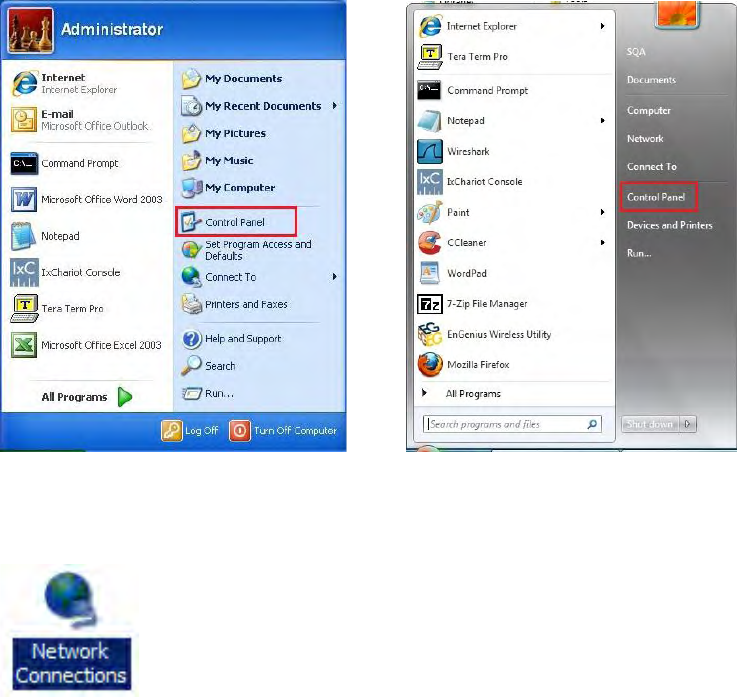
Computer Settings
Windows XP/Windows 7
In order to use the Access Point, you must first configure the TCP/IPv4 connection of your Windows OS computer system.
1. Click the Start button and open the Control Panel.
Windows XP Windows 7
2a. In Windows XP, click on Network Connections.
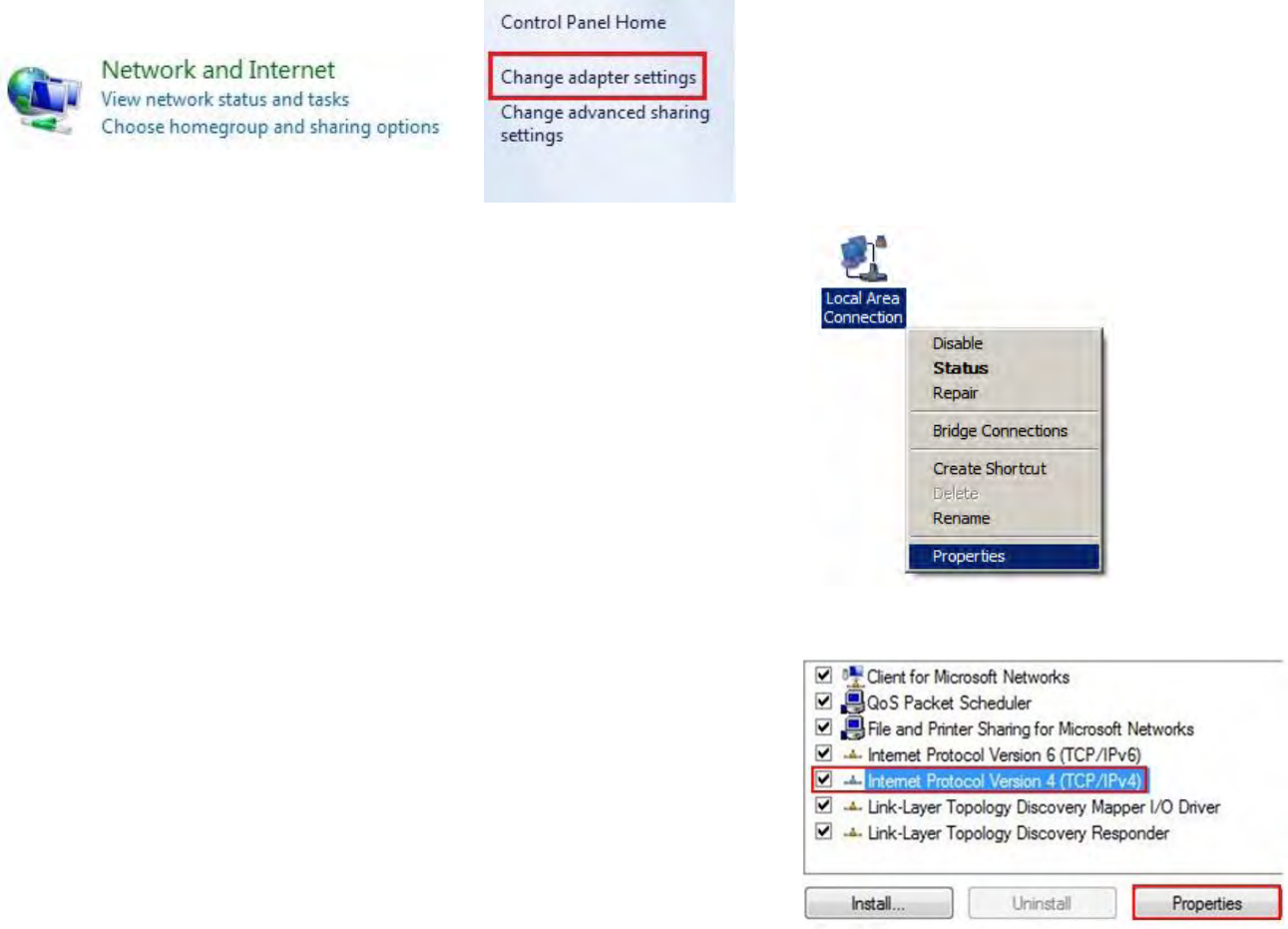
2b. In Windows 7, click View network status and tasks in the Network and Internet section, then select Change adapter
settings.
3. Right click on Local Area Connection and select Properties.
4. Select Internet Protocol Version 4 (TCP/IPv4) and then select Properties.
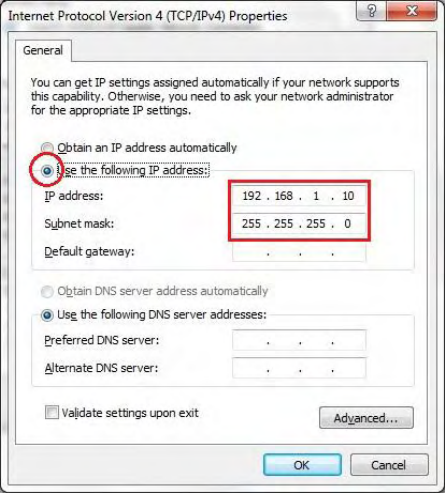
5. Select Use the following IP address and enter an IP address that is different from the
Access Point and Subnet mask, then click OK.
Note: Ensure that the IP address and Subnet mask are on the same subnet as the
device.
For example: Access Point IP address: 192.168.1.1
PC IP address: 192.168.1.2 – 192.168.1.255
PC Subnet mask: 255.255.255.0
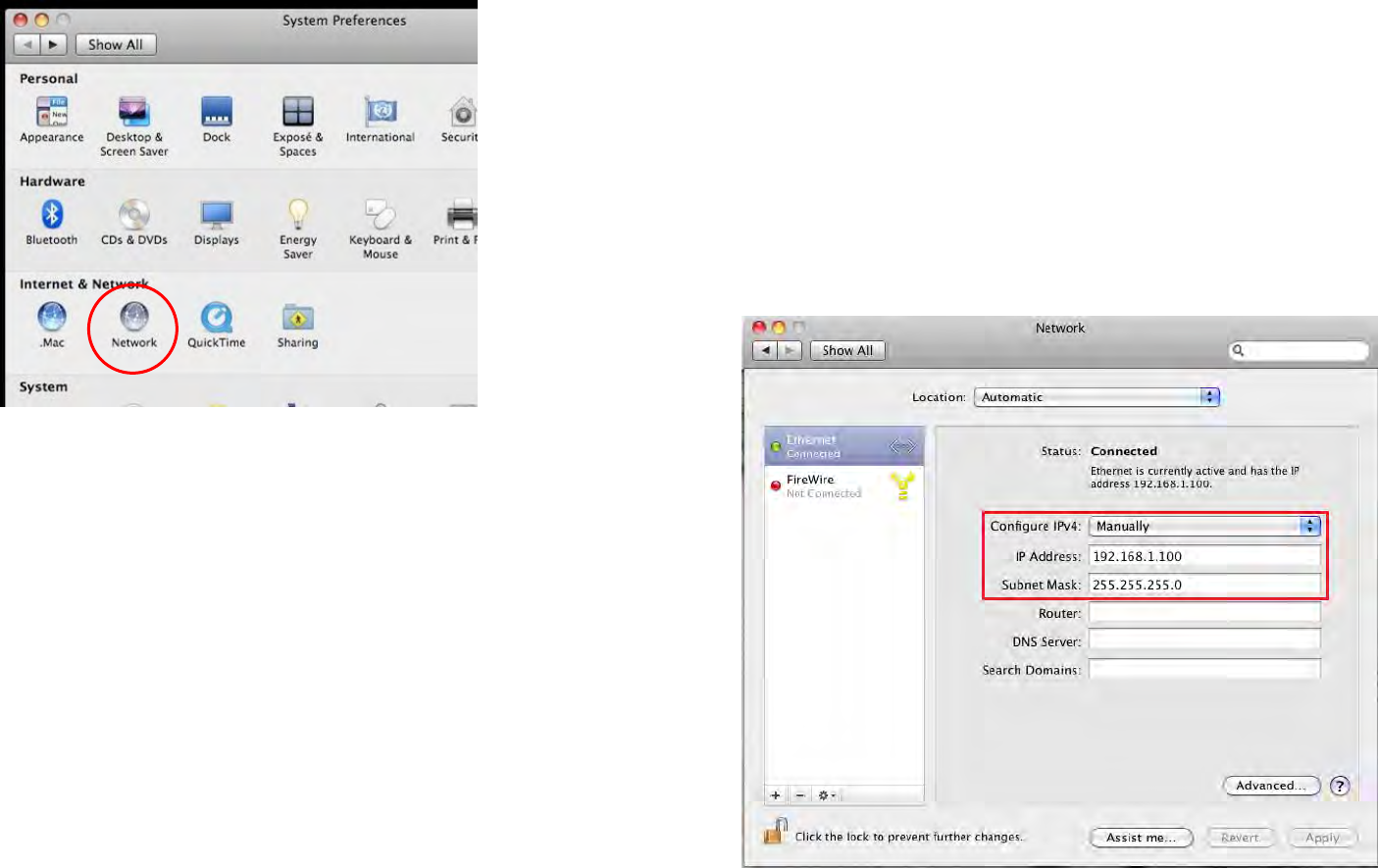
Apple Mac OS X
1. Go to System Preferences (it can be opened in the Applications folder or by selecting it in the Apple Menu).
2. Select Network in the Internet & Network section.
3. Highlight Ethernet.
4. In Configure IPv4, select Manually.
5. Enter an IP address that is different from the Access Point and
Subnet mask, then click OK.
Note: Ensure that the IP address and Subnet mask are on the same
subnet as the device.
For example: Access Point IP address: 192.168.1.1
PC IP address: 192.168.1.2 – 192.168.1.255
PC Subnet mask: 255.255.255.0
6. Click Apply when finished.
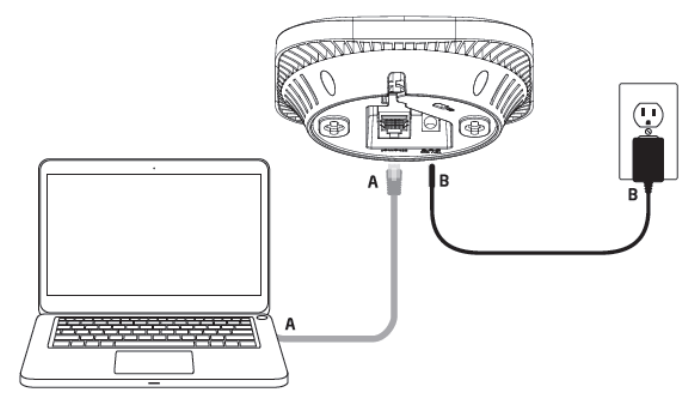
Hardware Installation
1. Ensure that the computer in use has an Ethernet Controller port (RJ-45 Ethernet Port). For more information, verify with your
computer’s user manual.
2. Connect one end of the Category 5e Ethernet cable into the RJ-45 port of the Access Point and the other end to the RJ-45
port of the computer. Ensure that the cable is securely connected to both the Access Point and the computer.
3. Connect the Power Adapter DC connector to the DC-IN port of the Access Point and the Power Adapter to an available
electrical outlet. Once both connections are secure, verify the following:
a) Ensure that the POWER LED is on.
b) Ensure that the 2.4 GHz LED is on.
c) Ensure that the LAN (Computer/ Access Point Connection) light is on.
d) Once all three lights are on, proceed to set up the Access Point using the computer.
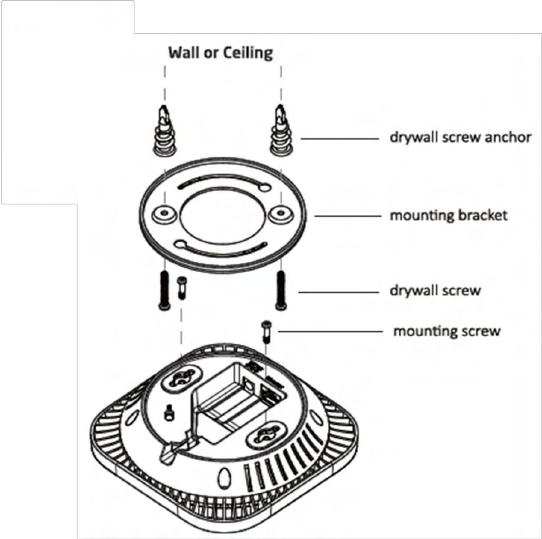
Mounting the Access Point
Using the provided hardware, the Access Point can be attached to a ceiling or wall.
To attach the Access Point to a ceiling or wall using the mounting bracket:
1. Attach the mounting bracket to the wall or ceiling using the provided wall/ceiling mounting hardware kit.
2. Insert the provided short screws into the bottom cover of the Access Point.
Leave enough of the screws exposed to ensure that the unit can be attached to the mounting bracket.
If extra space is required, use the provided spacers and long screws from the T-Rail mounting hardware kit to increase the space
between the unit and the mounting bracket.
4. Mount the Access Point on the mounting bracket by rotating the unit clockwise about 90 degrees to secure it in place.
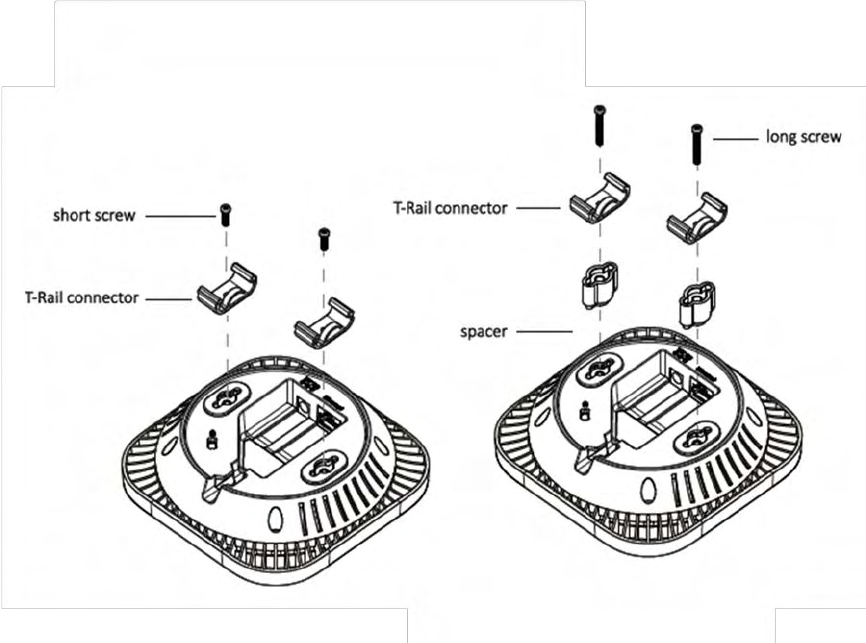
Attaching the Access Point to a ceiling using the provided T-Rail connectors:
1. Attach the T-Rail connectors to the bottom cover of the Access Point using the provided short screws.
Note: Two sizes of T-Rail connectors are included in the mounting hardware kit: 15/16in (2.38cm) and 9/16in (1.43cm). If extra
space is required to accommodate drop ceiling tiles, use the provided spacers and long screws.
2. Line up the connected T-Rail connectors with an appropriately sized rail and press the unit onto the rail until it snaps into
place.
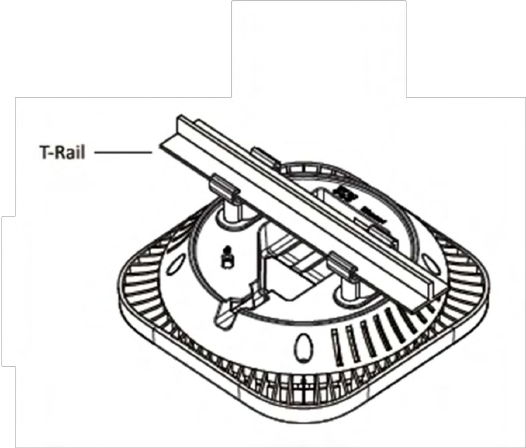
Note: To protect your Access Point, use the Kensington Security Slot to attach a cable lock (cable lock is not included).
Chapter 3
Configuring Your Access Point

Configuring Your Access Point
This section will show you how to configure the device using the web-based configuration interface.
Default Settings
Please use your Ethernet port or wireless network adapter to connect the Access Point.
IP Address
192.168.1.1
Username/Password
admin/admin
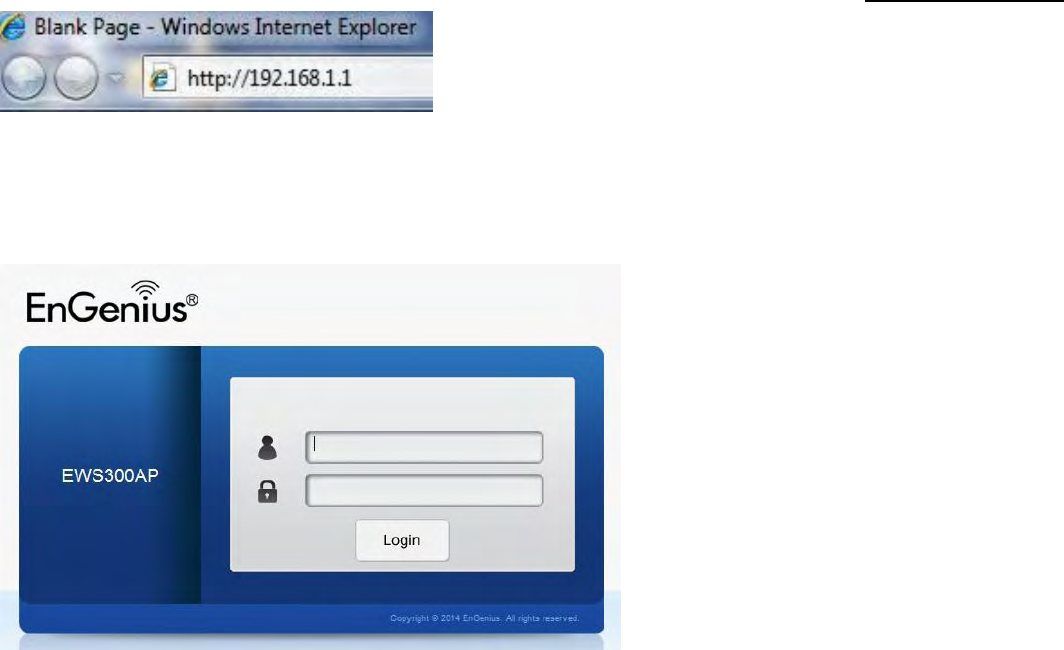
Web Configuration
1. Open a web browser (Internet Explorer/Firefox/Safari) and enter the IP Address http://192.168.1.1.
Note: If you have changed the default LAN IP Address of the Access Point, ensure you enter the correct IP Address.
2. The default username and password are: admin. Once you have entered the correct username and password, click the Login
button to open the web-based configuration page.
3. If successful, you will be logged in and see the Access Point User Interface.
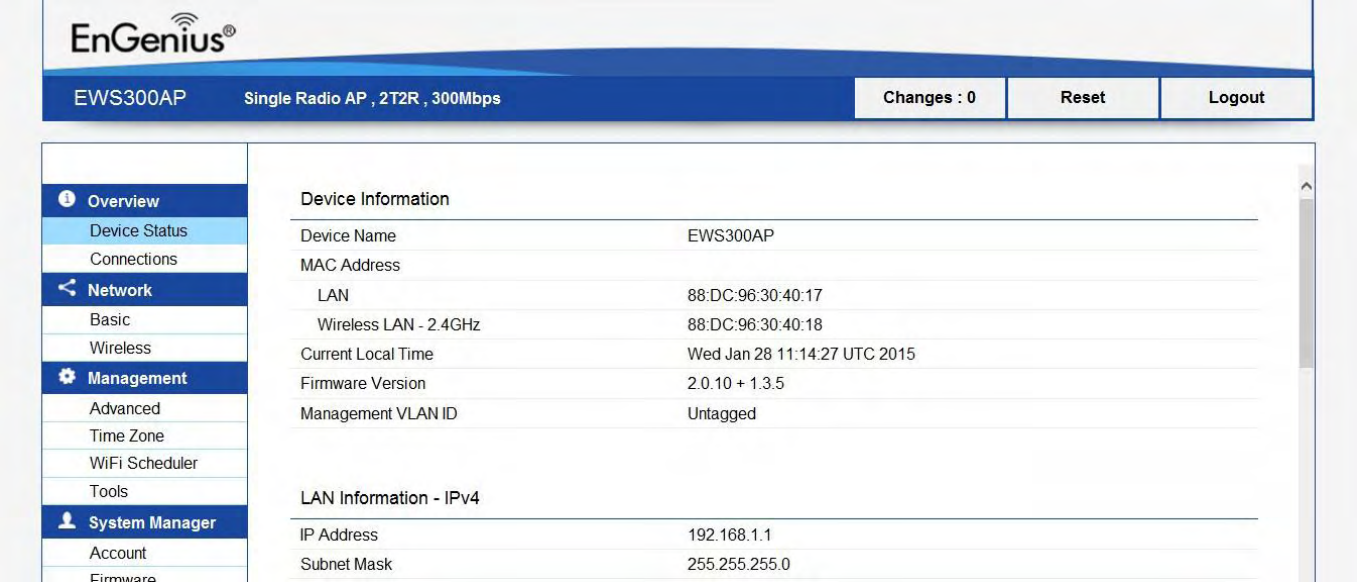
Chapter 4
Overview
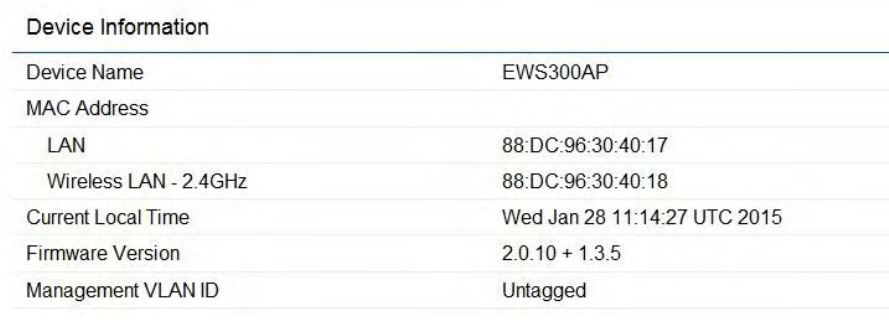
Overview
The Overview section contains the following options:
• Device Status
• Connections
The following sections describe these options.
Device Status
Clicking the Device Status link under the Overview menu shows the status information about the current operating mode.
The Device Information section shows general system information such as Device Name, MAC address, Current Time,
Firmware Version, and Management VLAN ID
The LAN Information section shows the Local Area Network settings such as the LAN IP Address, Subnet mask, Gateway,
DNS Address, DHCP Client, and STP status.
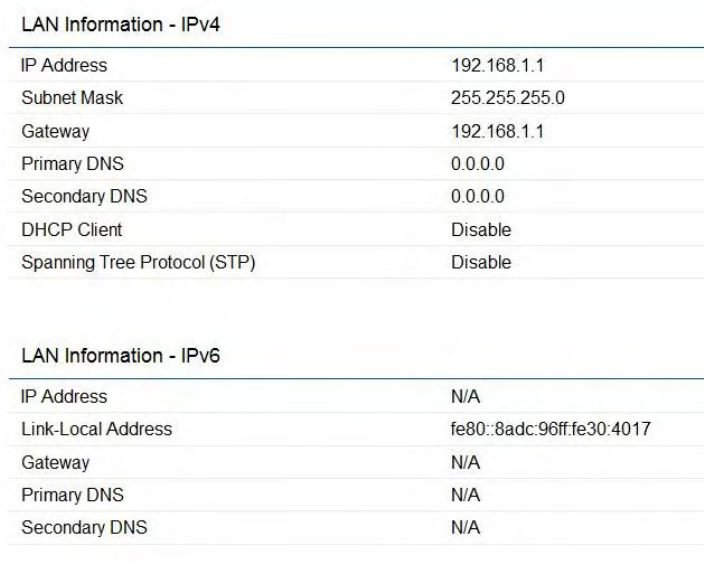
The Wirelesss LAN Information 2.4 GHz section shows wireless information such as Operating Mode, Frequency, and
Channel. Since the Access Point supports multiple-SSIDs, information about each SSID and security settings are displayed.
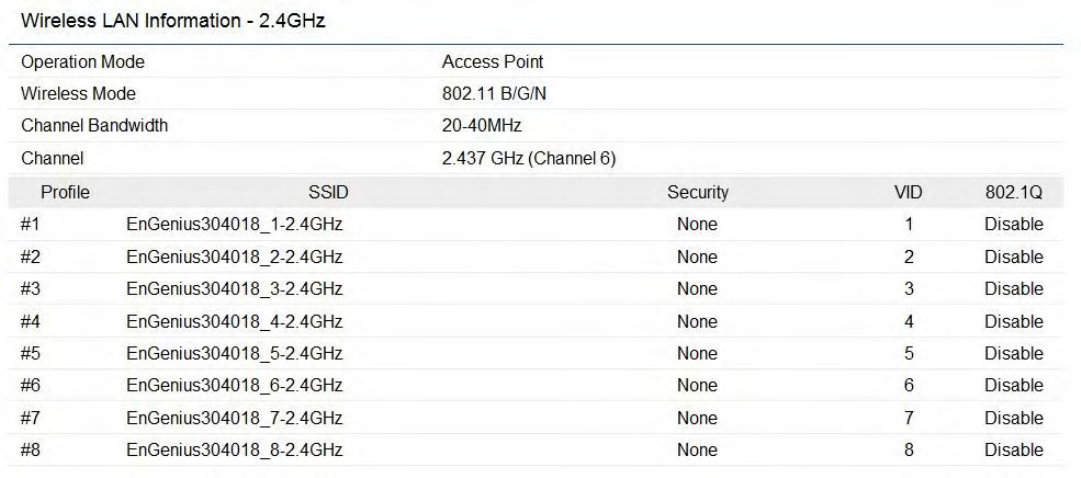

Connections
Clicking the Connections link under the Device Status menu displays the list of clients associated to the Access Point’s 2.4GHz
band along with the MAC address, TX, RX and signal strength for each client. Clicking Kick in the Block column removes this
client.
Click Refresh to refresh the Connection List page.
Chapter 5
Network
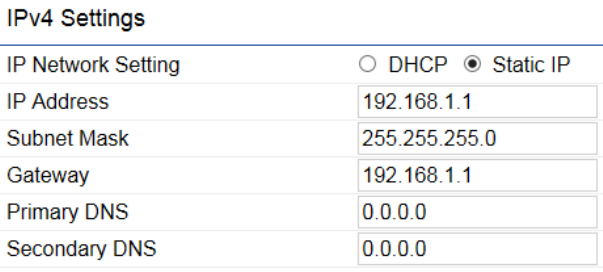
Basic
This page allows you to modify the device’s IP settings and the Spanning Tree settings. Enabling Spanning Tree protocol will
prevent network loops in your LAN network.
IPv4 Settings
IP Network Setting: Select whether the device IP address will use the static IP address specified in the IP Address field or be
obtained automatically when the device connects to a DHCP server.
IP Address: The IP Address of this device.
IP Subnet Mask: The IP Subnet mask of this device.
Gateway: The Default Gateway of this device. Leave it blank if you are unsure of this setting.
Primary/Secondary DNS: The primary/secondary DNS address for this device.
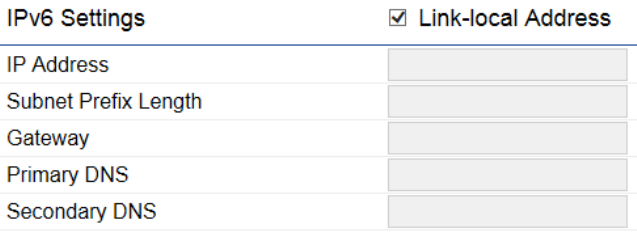
IPv6 Settings
Link-Local Address: Check this if you want to use Link-Local Address.
IP Address: The IPv6 IP Address of this device.
Subnet Prefix Length: The IPv6 Subnet Prefix Length of this device.
Gateway: The IPv6 Default Gateway of this device. Leave it blank if you are unsure of this setting.
Primary / Secondary DNS: The primary / secondary DNS address for this device.
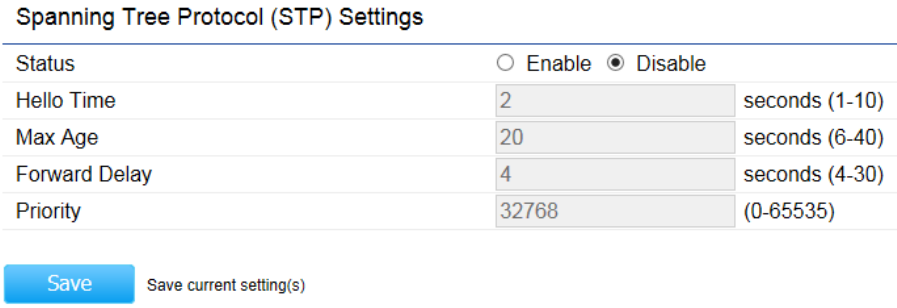
Spanning Tree Settings
Status: Enables or disables the Spanning Tree function.
Hello Time: Specify Bridge Hello Time, in seconds. This value determines how often the device sends handshake packets to
communicate information about the topology throughout the entire Bridged Local Area Network.
Max Age: Specify Bridge Max Age, in seconds. If another bridge in the spanning tree does not send a hello packet for a long period
of time, it is assumed to be inactive.
Forward Delay: Specifies Bridge Forward Delay, in seconds. Forwarding Delay Time is the time spent in each of the Listening and
Learning states before the Forwarding state is entered. This delay is provided so that when a new bridge comes onto a busy
network, it analyzes data traffic before participating.
Priority: Specify the Priority Number. A smaller number has greater priority.
Save: Click Save to confirm the changes.
Chapter 6
2.4GHz Wireless

2.4GHz SSID Profile
Under Wireless Settings, you can edit the SSID profile to fit your needs. Click Edit under the SSID you would like to make changes
to.
Enable: Check this option to enable this profile.
SSID: Specifies the SSID for the current profile.
Security: Displays the Security Mode the SSID uses. You can click Edit to change the security mode. For more details, see the next
section.
Hidden SSID: Check this option to hide the SSID from clients. If checked, the SSID will not appear in the site survey.
Client Isolation: Check this option to prevent communication between client devices.
VLAN Isolation: Check this option to enable VLAN Isolation feature.
VLAN ID: Specifies the VLAN ID for the SSID profile.
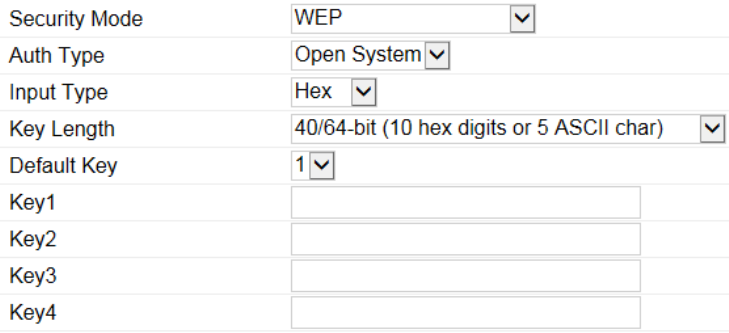
Wireless Security
The Wireless Security section lets you configure the Access Point’s security modes: WEP, WPA-PSK, WPA2-PSK, WPA-PSK Mixed,
WPA-Enterprise, WPA2-Enterprise and WPA Mixed Enterprise.
It is strongly recommended that you use WPA2-PSK. Click on the Edit button under Wireless Settings next to the SSID to change
the security settings.
WEP
Auth Type: Select Open System or Shared Key.
Input Type: ASCII: Regular Text (Recommended) or HEX: Hexadecimal Numbers (For advanced users).
Key Length: Select the desired option and ensure the wireless clients use the same setting. Your choices are: 64, 128, and 152-bit
password lengths.
Default Key: Select the key you wish to be default. Transmitted data is ALWAYS encrypted using the Default Key; the other Keys
are for decryption only. You must enter a Key Value for the Default Key.
Encryption Key: Enter the Key Value or values you wish to use. The default is none.
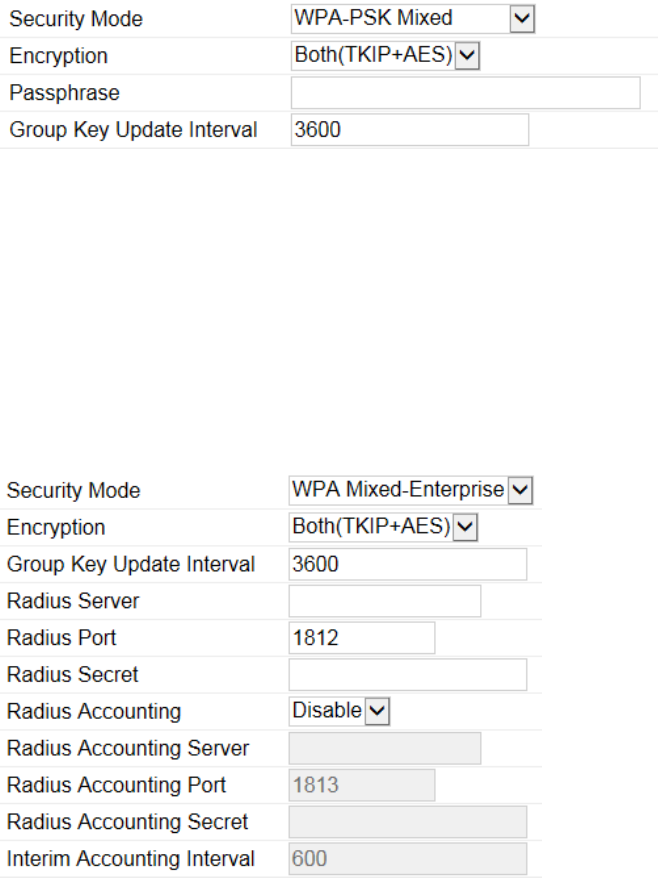
WPA-PSK/WPA2-PSK (Pre-Shared Key)
Encryption: Select the WPA/WPA2 encryption type you would like to use. Available options are Both, TKIP(Temporal Key Integrity
Protocol) and AES(Advanced Encryption Standard). Please ensure that your wireless clients use the same settings.
Passphrase: Wireless clients must use the same Key to associate the device. If using ASCII format, the Key must be from 8 to 63
characters in length. If using HEX format, the Key must be 64 HEX characters in length.
Group Key Update Interval: Specify how often, in seconds, the Group Key changes.
WPA/WPA2-Enterprise
Encryption: Select the WPA/WPA2 encryption type you would like to use. Available options are Both, TKIP(Temporal Key Integrity
Protocol) and AES(Advanced Encryption Standard). Please ensure that your wireless clients use the same settings.
Group Key Update Interval: Specify how often, in seconds, the group key changes.
Radius Server: Enter the IP address of the Radius server.
Radius Port: Enter the port number used for connections to the Radius server.
Radius Secret: Enter the secret required to connect to the Radius server.
Radius Accounting: Enables or disables the accounting feature.
Radius Accounting Server: Enter the IP address of the Radius accounting server.
Radius Accounting Port: Enter the port number used for connections to the Radius accounting server.
Radius Accounting Secret: Enter the secret required to connect to the Radius accounting server.
Interim Accounting Interval: Specify how often, in seconds, the accounting data sends.
Note: 802.11n does not allow WEP/WPA-PSK TKIP/WPA2-PSK TKIP security mode. The connection mode will automatically change
from 802.11n to 802.11g.

Wireless MAC Filter
Wireless MAC Filter is used to allow or deny network access to wireless clients (computers, tablet PCs, NAS, smart phones, etc.)
according to their MAC addresses. You can manually add a MAC address to restrict permission to access the Access Point. The
default setting is: Disable Wireless MAC Filter.
ACL (Access Control List) Mode: Determines whether network access is granted or denied to clients whose MAC addresses appear
in the MAC address table on this page. Choices given are: Disabled, Deny MAC in the list, or Allow MAC in the list.
MAC Address: Enter the MAC address of the wireless client.
Add: Click Add to add the MAC address to the MAC Address table.
Delete: Deletes the selected entries.
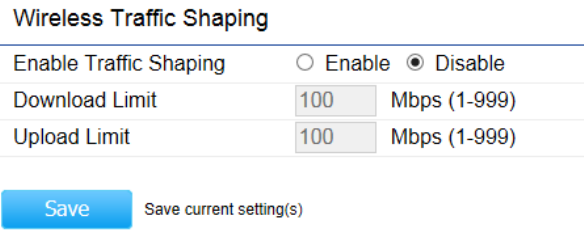
Traffic Shaping
Traffic Shaping regulates the flow of packets leaving an interface to deliver improved Quality of Service.
Enable Traffic Shaping: Select to Enable or Disable Wireless Traffic Shaping.
Download Limit: Specifies the wireless transmission speed used for downloading.
Upload Limit: Specifies the wireless transmission speed used for uploading.
Save: Click Save to apply the changes.

Guest Network
The Guest Network function allows administrators to grant Internet connectivity to visitors or guests while keeping other
networked devices (computers and hard drives) and sensitive personal or company information private and secure.
Enable SSID: Select to Enable or Disable SSID broadcasting.
SSID: Specify the SSID for the current profile. This is the name visible on the network to wireless clients.
Security: You can use None or WPA-PSK / WPA2-PSK security for this guest network.
Hidden SSID: Check this option to hide the SSID from broadcasting to discourage wireless users from connecting to a particular
SSID.
Client Isolation: Check this option to prevent wireless clients associated with your access point to communicate with other
wireless devices connected to the AP.
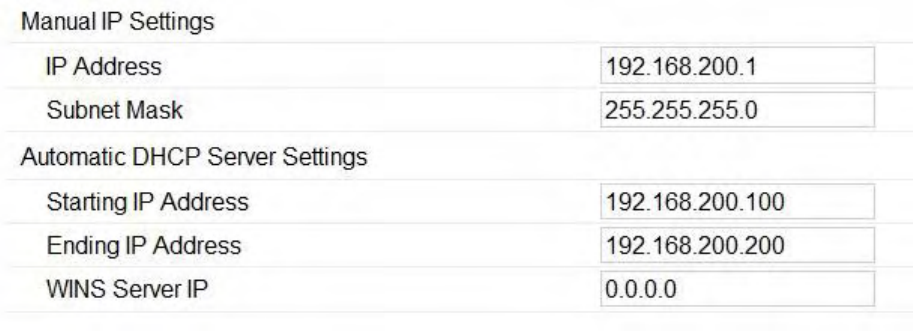
After enabling Guest Network in the SSID Config page, assign an IP Address, Subnet Mask and DHCP server IP address range for
this Guest Network.
Manual IP Settings
IP Address: Specify an IP Address for the Guest Network
Subnet Mask: Specify the the Subnet Mask IP Address for the Guest Network
Automatic DHCP Server Settings
Starting IP Address: Specify the starting IP Address range for the Guest Network.
Ending IP Address: Specify the ending IP Address range for the Guest Network.
WINS Server IP: Specify the WINS Server IP Address for the Guest Network. WINS means Windows Internet Name Service. It is
Microsoft's implementation of NetBIOS Name Service (NBNS), a name server and service for NetBIOS computer names.

Fast Handover
With Fast Handover enabled, the AP will send a disassociation request to the wireless client and let it find another AP to
handover and associate upon detecting the wireless client’s RSSI value lower than specified. The RSSI value can be adjusted to
allow more clients to stay associated to this AP. Note that setting the RSSI value too low may cause wireless clients to
reconnect frequently.

Management VLAN Settings
This section allows you to assign a VLAN tag to the packets. A VLAN is a group of computers on a network whose software has
been configured so that they behave as if they were on a separate Local Area Network (LAN). Computers on VLAN do not have
to be physically located next to one another on the LAN.
Status: If your network includes VLANs and if tagged packets need to pass through the Access Point, select Enable and enter
the VLAN ID. Otherwise, click Disable.
Save: Click Save to apply the changes.
Note: If you reconfigure the Management VLAN ID, you may lose your connection to the Access Point. Verify that the DHCP
server supports the reconfigured VLAN ID and then reconnect to the Access Point using the new IP address.
Chapter 7
Management
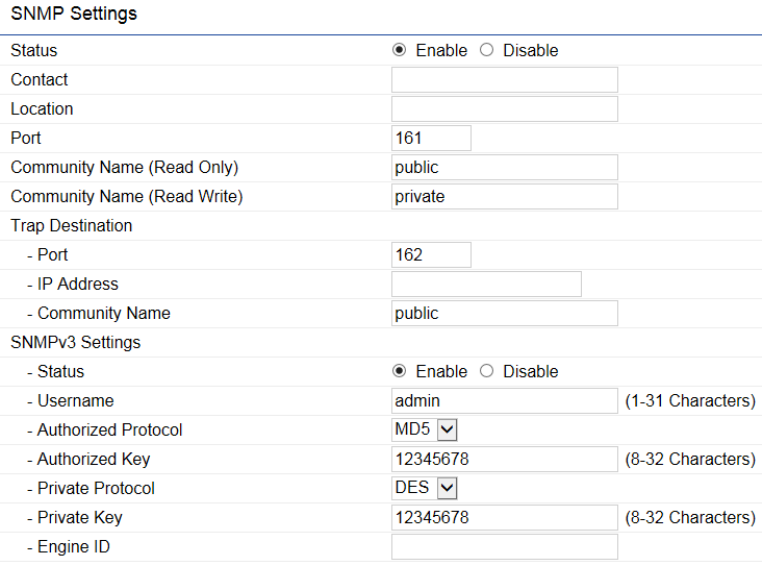
SNMP Settings
This page allows you to assign the Contact Details, Location, Community Name, and Trap Settings for Simple Network Management
Protocol (SNMP). This is a networking management protocol used to monitor network attached devices. SNMP allows messages (called
protocol data units) to be sent to various parts of the network. Upon receiving these messages, SNMP compatible devices (called agents)
returns the data stored in their Management Information Bases. To configure SNMP Settings, click under the Advanced tab on the side
bar under Management.
Status: Enables or Disables the SNMP feature.
Contact: Specifies the contact details of the device.
Location: Specifies the location of the device.
Port: Displays the port number.
Community Name (Read Only): Specifies the password for the SNMP community for read only access.
Community Name (Read/Write): Specifies the password for the SNMP community with read/write access.
Trap Destination Address: Specifies the port and IP address of the computer that will receive the SNMP traps.
Trap Destination Community Name: Specifies the password for the SNMP trap community.
SNMPv3 Status: Enables or Disables the SNMPv3 feature.
User Name: Specifies the username for the SNMPv3.feature
Auth Protocol: Select the Authentication Protocol type: MDS or SHA.
Auth Key: Specify the Authentication Key for authentication.
Priv Protocol: Select the Privacy Protocol type: DES.
Priv Key: Specifies the privacy key for privacy.
Engine ID: Specifies the Engine ID for SNMPv3.

CLI/SSH Settings
Most users will configure the device through the graphical user interface (GUI). However, for those who prefer an alternative
method there is the command line interface (CLI). The CLI can be access through a command console, modem or Telnet connection.
For security’s concern, you can enable SSH (Secure Shell) to establish a secure data communication.
CLI Status: Select Enable or Disable to enable or disable the ability to modify the Access Point via a command line interface (CLI).
SSH Status: Select Enable or Disable to enable or disable the ability to modify the Access Point via a command line interface (CLI)
with a secure channel.

HTTPS Settings
Hypertext Transfer Protocol Secure (HTTPS) is a communications protocol for secure communication over a computer network, with
especially wide deployment on the Internet. Technically, it is not a protocol in and of itself; rather, it is the result of simply layering
the Hypertext Transfer Protocol (HTTP) on top of the SSL/TLS protocol, thus adding the security capabilities of SSL/TLS to standard
HTTP communications.
Status: Select Enable or Disable to enable or disable the ability to modify the Access Point via a HTTPS.
HTTPS forward: Enable this option; it will be forwarded to HTTPS if user uses HTTP to access the Access Point.
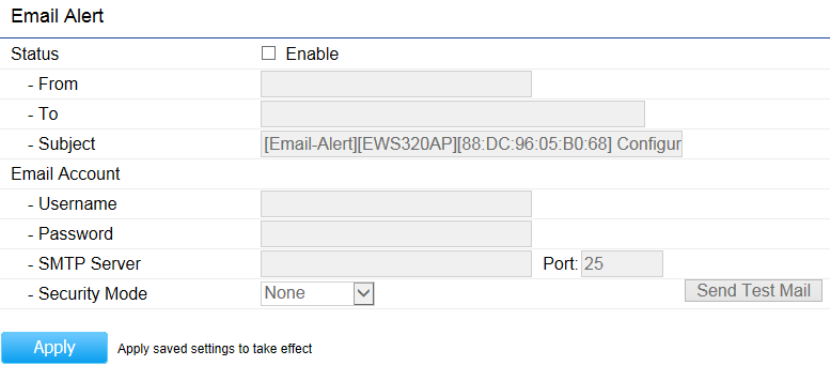
Email Alert
The Access Point will send email alerts when configurations have been changed.
Status: Check Enable to enable Email Alert feature.
From: Enter the address to show as the sender of the email.
To: Enter the address to show as the receiver of the email.
Subject: Enter the subject to show as the subject of the email.
Email Account
Username/Password: Enter the username and password required to connect to the SMTP server.
SMTP Server/Port: Enter the IP address/domain name and port of the SMTP server. The default port of SMTP Server is port 25.
Security Mode: Select the mode of security for the Email alert. The options are None, SSL/TLS and STARTTLS.
Send Test Mail: Click Send Test Mail button to test the Email Alert setup.
Apply: Click Apply to save the changes.
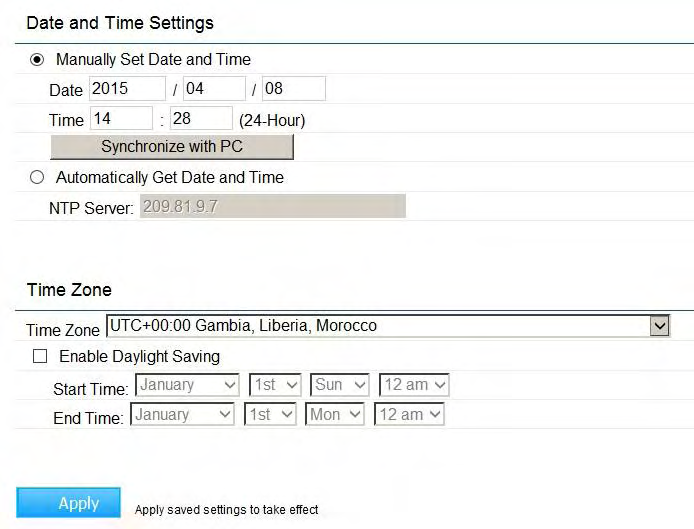
Date and Time Settings
This page allows you to set the internal clock of the Access Point. To access the Date and Time settings, click Time Zone
under the Management tab on the side bar.
Manually Set Date and Time: Manually specify the date and time.
Synchronize with PC: Click to synchronize the Access Point’s internal clock with the computer’s time.
Automatically Get Date and Time: Enter the IP address of an NTP server or use the default NTP server to have the
internal clock set automatically.
Time Zone: Choose the time zone you would like to use from the drop-down list.
Enable Daylight Savings: Check the box to enable or disable daylight savings time for the Access Point. Next, enter the
dates that correspond to the present year’s daylight savings time.
Click Apply to save the changes.

WiFi Scheduler
Use the schedule function to reboot the Access Point or control the wireless availability on a routine basis. The Schedule
function relies on the GMT time setting acquired from a network time protocol (NTP) server. For details on how to connect
the Access Point to an NTP server, see Date and Time Settings.
Auto Reboot Settings
You can specify how often you would like to reboot the Access Point.
Status: Enables or disables the Auto Reboot function.
Timer: Specifies the time and frequency in rebooting the Access Point by Min, Hour and Day.
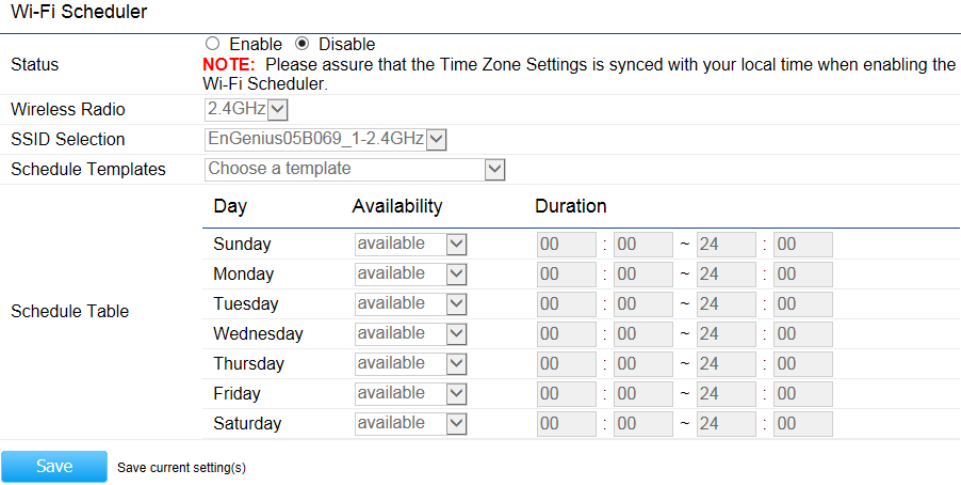
WiFi Scheduler
Status: Enables or disables the WiFi Scheduler function.
SSID Selection: Select a SSID to use WiFi Schedule.
Schedule Templates: There are 3 templates available: Always available, Available 8-5 daily and Available 8-5 daily except
weekends. Select Custom schedule if you want to set the schedule manually.
Schedule Table: Set the schedule manually.
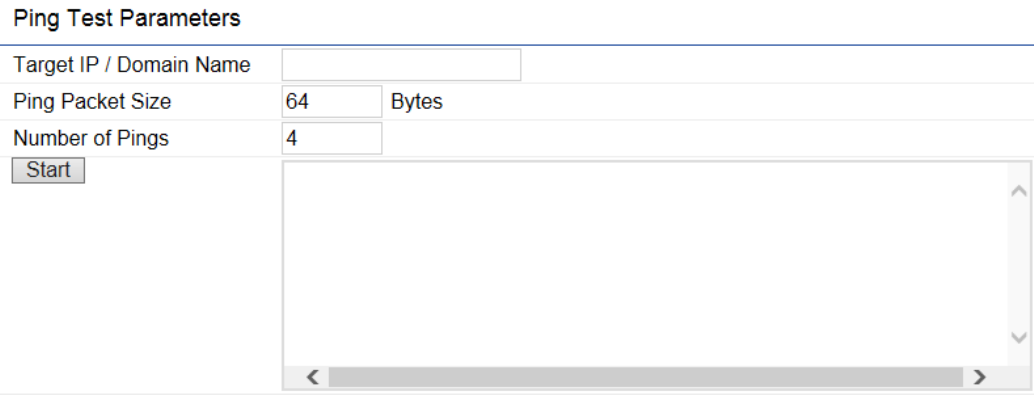
Tools
This section allows you to analyze the connection quality of the Access Point and trace the routing table to a target in the
network.
Ping Test Parameters
Target IP/Domain Name: Enter the IP address or Domain name you would like to search.
Ping Packet Size: Enter the packet size of each ping.
Number of Pings: Enter the number of times you wish to ping.
Start: Click Start to begin pinging target device (via IP).

Traceroute Parameters
Target IP/Domain Name: Enter an IP address or domain name you wish to trace.
Start: Click Start to begin the trace route operation.
Stop: Halts the traceroute test.
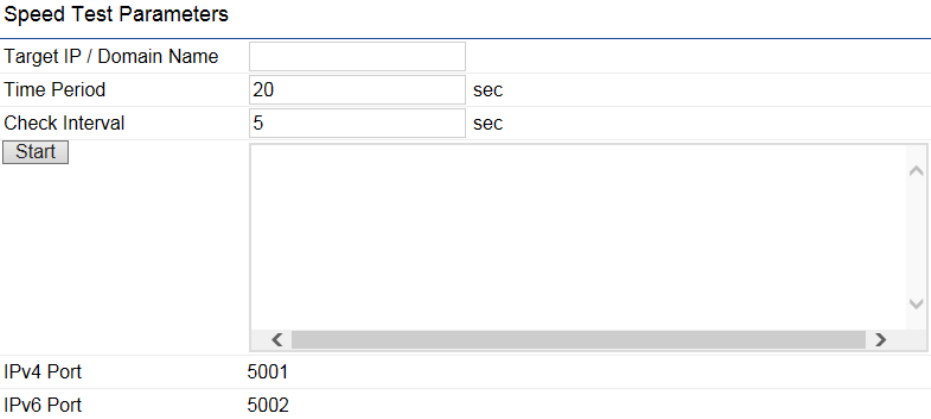
Speed Test Parameters
Target IP/Domain Name: Enter an IP address or domain name you wish to run a Speed Test for.
Time Period: Enter the time in seconds that you would like the test to run for and in how many intervals.
Start: Starts the Speed Test.
IPv4 / IPv6 Port: The Access Point uses IPv4 port 5001 and IPv6 port 5002 for the speed test.
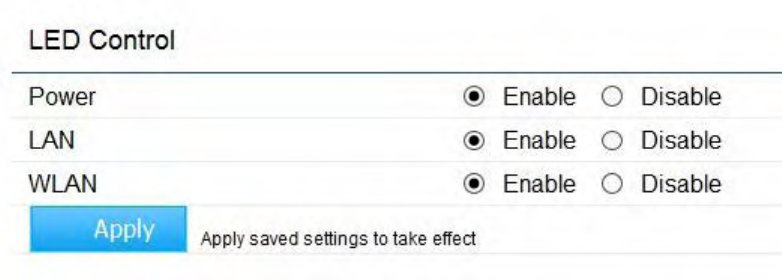
LED Control
This section allows you to control the LED control functions: Power status, LAN interface and WLAN interface.
Click Apply to save the settings after selecting your choices from the boxes.

Device Discovery
Under Device Discovery, you can choose for the Access Point to automatically scan for local devices to connect to. Click Scan to
begin the process.
Chapter 8
System Manager
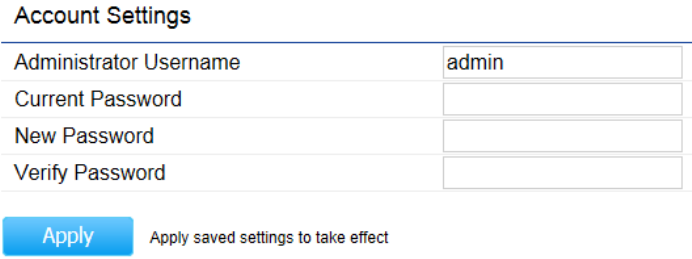
Account Setting
This page allows you to change the username and password of the device. By default, the username is admin and the password is
admin. The password can contain from 0 to 12 alphanumeric characters and is case sensitive.
Administrator Username: Enter a new username for logging in to the Administrator Username entry box.
Current Password: Enter the old password for logging in to the Current Password entry box.
New Password: Enter the new password for logging in to the New Password entry box.
Verify Password: Re-enter the new password in the Verify Password entry box for confirmation.
Apply: Click Apply to save the changes.
Note: it is highly recommended that you change your password to something more unique for greater security.
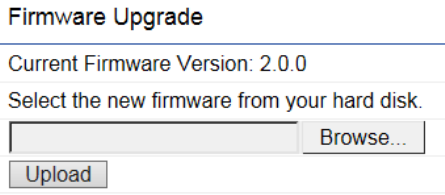
Firmware Upgrade
This page allows you to upgrade the Firmware of the Access Point.
To Perform the Firmware Upgrade:
1. Click the Browse… button and navigate the OS File System to the location of the Firmware upgrade file.
2. Select the upgrade file. The name of the file will appear in the Upgrade File field.
3. Click the Upload button to commence the Firmware upgrade.
Note: The device is unavailable during the upgrade process and must restart when the upgrade is completed. Any connections
to or through the device will be lost.

Backup/Restore
This page allows you to save the current device configurations. When you save the configurations, you can also reload the
saved configurations into the device through the Restore New Settings from a file folder. If extreme problems occur, or
if you have set the Access Point incorrectly, you can use the Reset button in the Reset to Default section to restore all
the configurations of the Access Point to the original default settings. To Configure the Backup/Restore Settings, click
Firmware under the Systems Manager tab.
Factory Setting
Backup Setting: Click Export to save the current device configurations to a file.
Restore New Setting: Choose the file you wish restore for settings and click Import.
Reset to Default: Click the Reset button to restore the Access Point to its factory default settings.
User Setting
Back Up Setting as Default: Click Backup to backup the user settings you would like to use as the default settings.
Restore to User Default: Click Restore to restore the Access Point to user’s default settings.
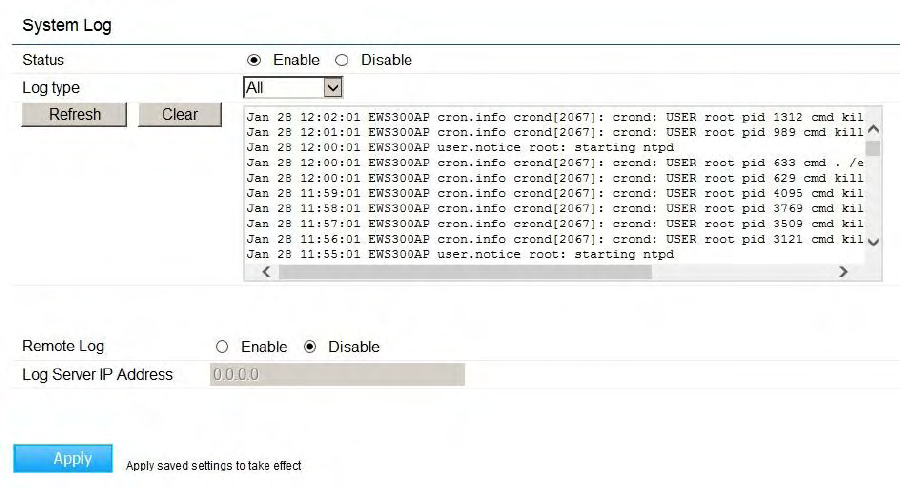
System Log
This page allows you to setup the System Log and local log functions of the Access Point. Click Log under the Systems
Manager tab to open up the System Log page.
Status: Enables or disables the System Log function.
Log Type: Select the Log Type mode you would like to use.
Remote Log: Enables or disables the Remote Log feature. If enabled, enter the IP address of the Log you would like to
remote to.
Log Server IP Address: Enter the IP address of the log server.
Apply: Click Apply to save the changes.
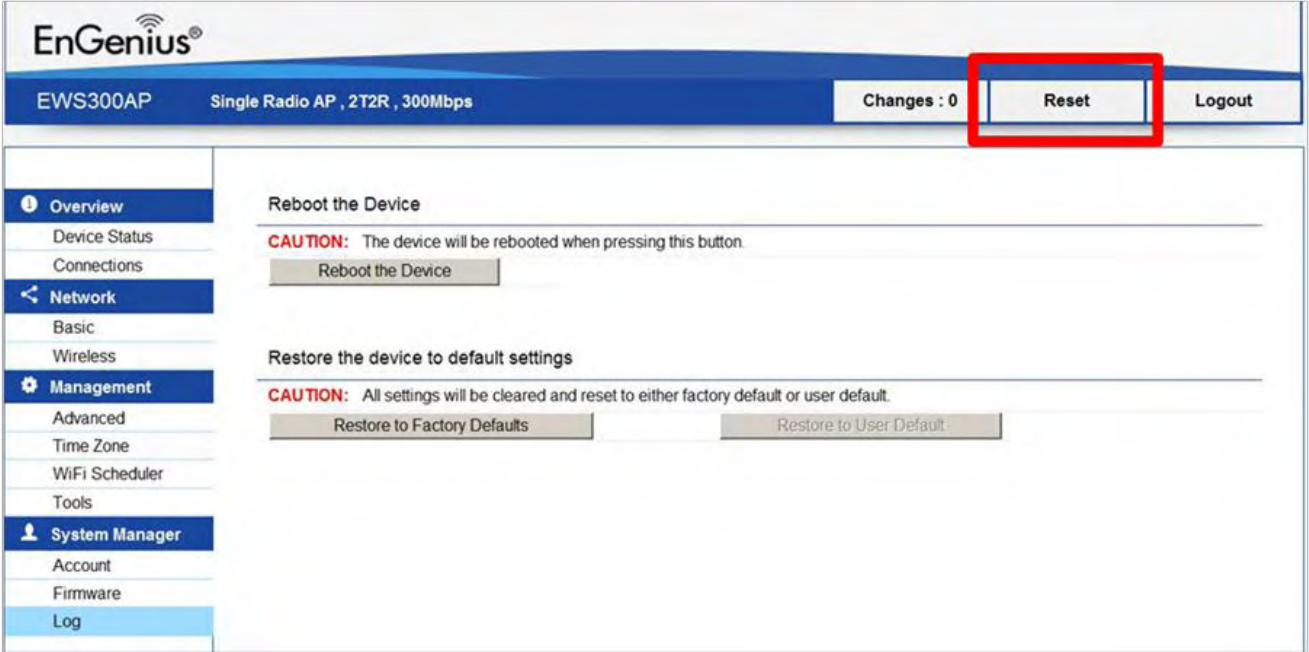
Reset
In some circumstances, you may be required to force the device to reboot. Click on Reboot the Device to reboot the device.
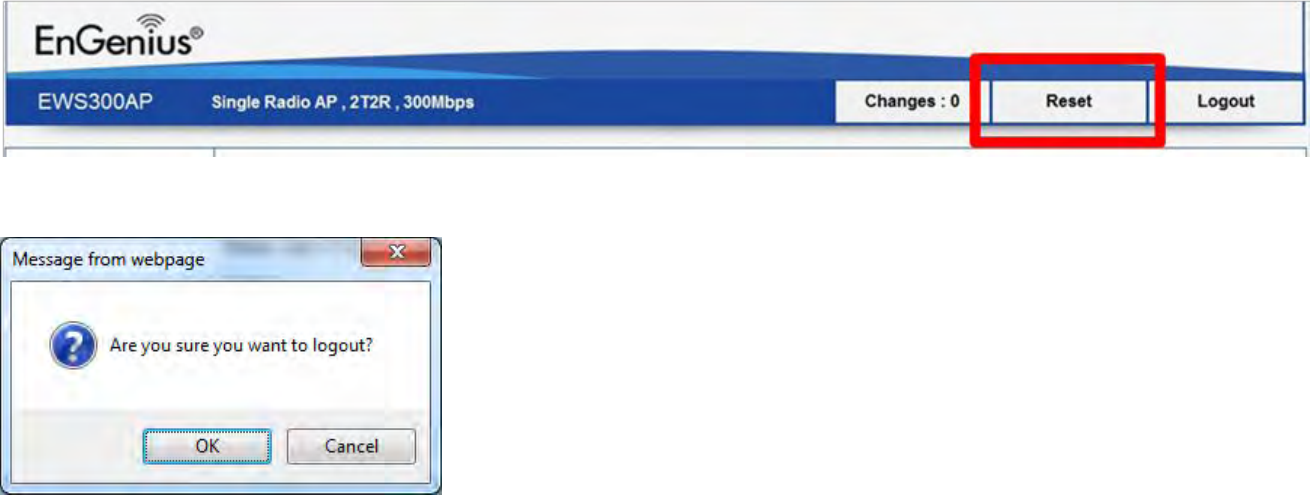
Logout
Click Logout, it will pop up a warning window. Click OK to logout.
Appendix
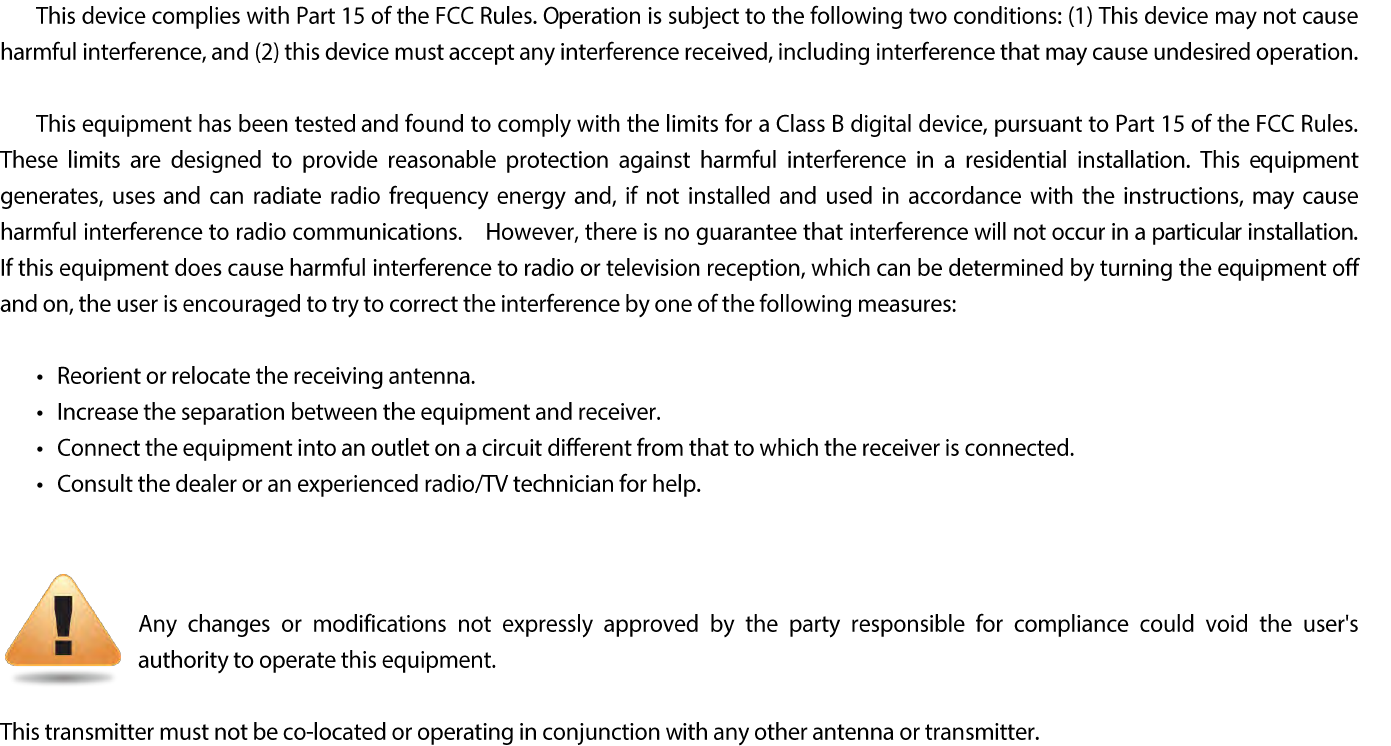
Appendix A - FCC Interference Statement
Federal Communication Commission Interference Statement
FCC Caution:

IMPORTANT NOTE:
Radiation Exposure Statement
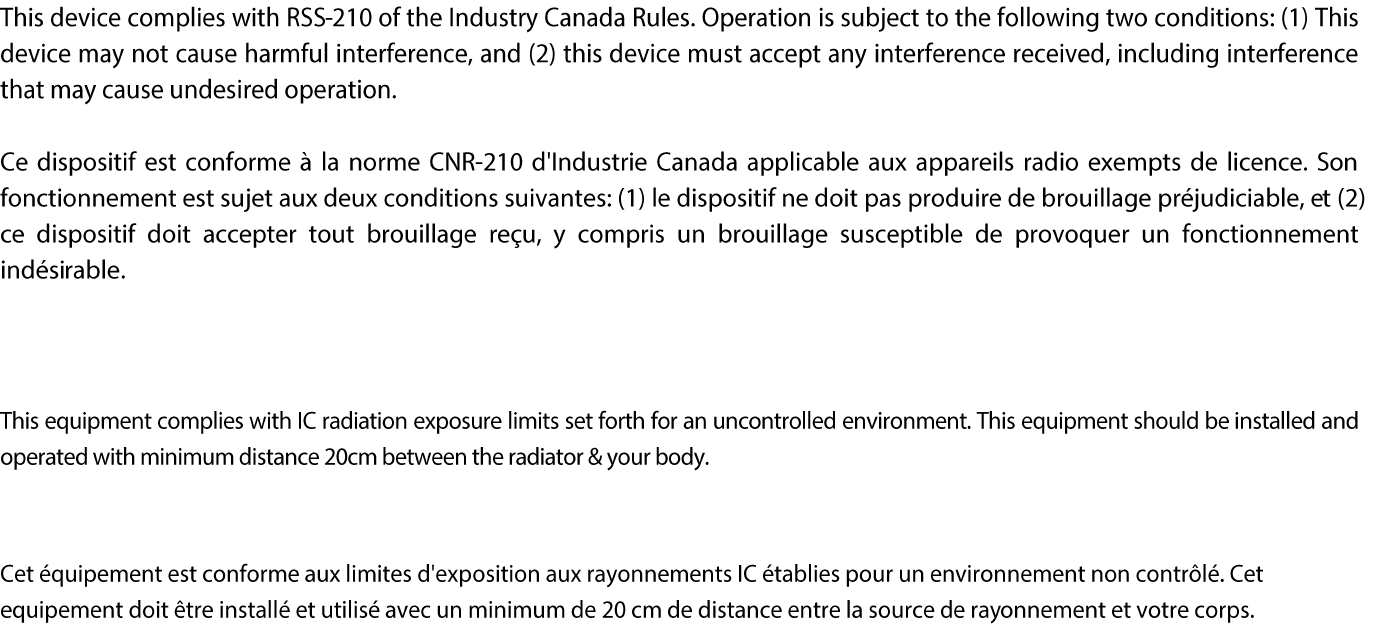
Appendix B - IC Interference Statement
Industry Canada Statement
Radiation Exposure Statement
Déclaration d’exposition aux radiations:
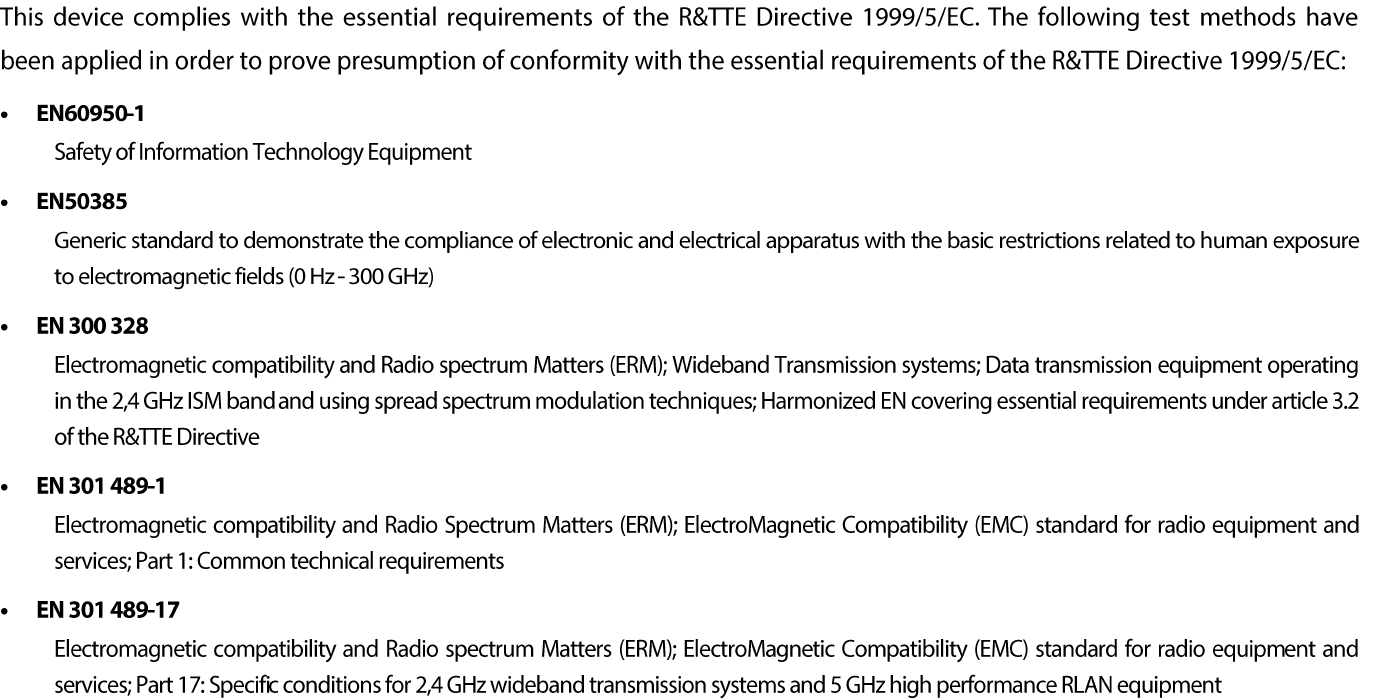
Appendix C - CE Interference Statement
Europe – EU Declaration of Conformity

Česky [Czech]
[Jméno výrobce] tímto prohlašuje, že tento [typ zařízení] je ve shodě se základními požadavky a dalšími příslušnými ustanoveními
směrnice 1999/5/ES.
Dansk [Danish]
Undertegnede [fabrikantens navn] erklæ rer herved, at følgende udstyr [udstyrets typebetegnelse] overholder de væ sentlige krav
og øvrige relevante krav i direktiv 1999/5/EF.
Deutsch [German]
Hiermit erklärt [Name des Herstellers], dass sich das Gerät [Gerätetyp] in Ü bereinstimmung mit den grundlegenden Anforderungen
und den übrigen einschlägigen Bestimmungen der Richtlinie 1999/5/EG befindet.
Eesti [Estonian]
Käesolevaga kinnitab [tootja nimi = name of manufacturer] seadme [seadme tüüp = type of equipment] vastavust direktiivi
1999/5/EÜ põhinõuetele ja nimetatud direktiivist tulenevatele teistele asjakohastele sätetele.
English
Hereby, [name of manufacturer], declares that this [type of equipment] is in compliance with the essential requirements and other
relevant provisions of Directive 1999/5/EC.
Español [Spanish]
Por medio de la presente [nombre del fabricante] declara que el [clase de equipo] cumple con los requisitos esenciales y
cualesquiera otras disposiciones aplicables o exigibles de la Directiva 1999/5/CE.
Ελληνική [Greek]
ΜΕ ΤΗΝ ΠΑΡΟΥΣΑ [name of manufacturer] ΔΗΛΩΝΕΙ ΟΤΙ [type of equipment] ΣΥΜΜΟΡΦΩΝΕΤΑΙ ΠΡΟΣ ΤΙΣ ΟΥΣΙΩΔΕΙΣ
ΑΠΑΙΤΗΣΕΙΣ ΚΑΙ ΤΙΣ ΛΟΙΠΕΣ ΣΧΕΤΙΚΕΣ ΔΙΑΤΑΞΕΙΣ ΤΗΣ ΟΔΗΓΙΑΣ 1999/5/ΕΚ.
Français [French]
Par la présente [nom du fabricant] déclare que l'appareil [type d'appareil] est conforme aux exigences essentielles et aux autres
dispositions pertinentes de la directive 1999/5/CE.
Italiano [Italian]
Con la presente [nome del costruttore] dichiara che questo [tipo di apparecchio] è conforme ai requisiti essenziali ed alle altre
disposizioni pertinenti stabilite dalla direttiva 1999/5/CE.
Latviski [Latvian]
Ar šo [name of manufacturer / izgatavotāja nosaukums] deklarē, ka [type of equipment / iekārtas tips] atbilst Direktīvas 1999/5/EK
būtiskajām prasībām un citiem ar to saistītajiem noteikumiem.
Lietuvių [Lithuanian]
Šiuo [manufacturer name] deklaruoja, kad šis [equipment type] atitinka esminius reikalavimus ir kitas 1999/5/EB Direktyvos
nuostatas.
Nederlands [Dutch]
Hierbij verklaart [naam van de fabrikant] dat het toestel [type van toestel] in overeenstemming is met de essentiële eisen en de

andere relevante bepalingen van richtlijn 1999/5/EG.
Malti [Maltese]
Hawnhekk, [isem tal-manifattur], jiddikjara li dan [il-mudel tal-prodott] jikkonforma mal-ħtiġijiet essenzjali u ma provvedimenti oħrajn
relevanti li hemm fid-Dirrettiva 1999/5/EC.
Magyar [Hungarian]
Alulírott, [gyártó neve] nyilatkozom, hogy a [... típus] megfelel a vonatkozó alapvetõ követelményeknek és az 1999/5/EC irányelv
egyéb elõírásainak.
Polski [Polish]
Niniejszym [nazwa producenta] oświadcza, że [nazwa wyrobu] jest zgodny z zasadniczymi wymogami oraz pozostałymi
stosownymi postanowieniami Dyrektywy 1999/5/EC.
Português [Portuguese]
[Nome do fabricante] declara que este [tipo de equipamento] está conforme com os requisitos essenciais e outras disposições da
Directiva 1999/5/CE.
Slovensko [Slovenian]
[Ime proizvajalca] izjavlja, da je ta [tip opreme] v skladu z bistvenimi zahtevami in ostalimi relevantnimi določili direktive 1999/5/ES.
Slovensky [Slovak]
[Meno výrobcu] týmto vyhlasuje, že [typ zariadenia] spĺňa základné požiadavky a všetky príslušné ustanovenia Smernice
1999/5/ES.
Suomi [Finnish]
[Valmistaja = manufacturer] vakuuttaa täten että [type of equipment = laitteen tyyppimerkintä] tyyppinen laite on direktiivin
1999/5/EY oleellisten vaatimusten ja sitä koskevien direktiivin muiden ehtojen mukainen.
Svenska [Swedish]
Härmed intygar [företag] att denna [utrustningstyp] står I överensstämmelse med de väsentliga egenskapskrav och övriga
relevanta bestämmelser som framgår av direktiv 1999/5/EG.